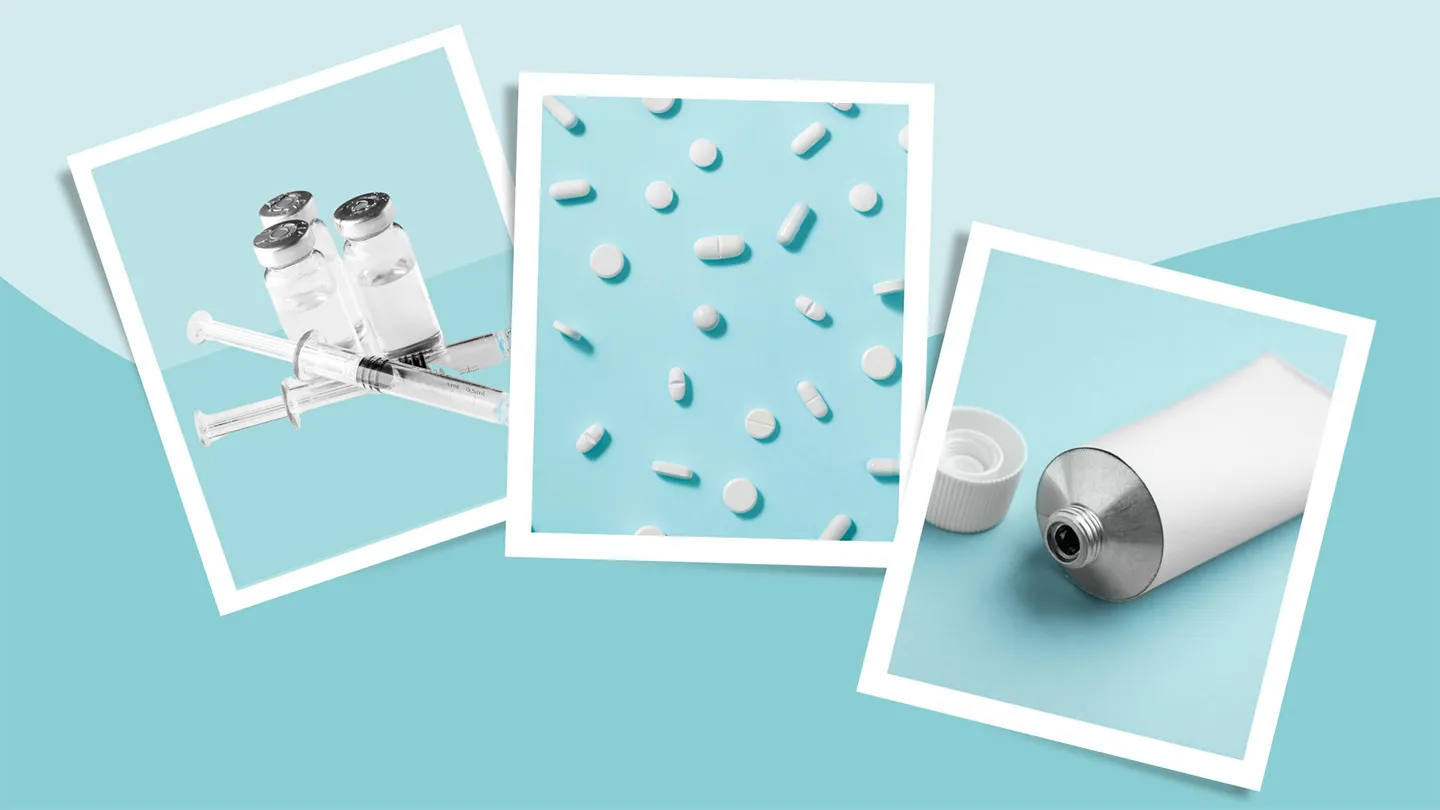Many treatments are available for graft-versus-host disease (GVHD), a severe complication that can occur after a transplant (typically after a bone marrow or stem cell transplant).e60dc2a1-f33c-4a05-9b50-8e3e8e59762929c842a6-42ee-475e-b467-0ec26e0bd582 GVHD occurs when immune cells from the donor’s graft recognize the recipient’s tissues as foreign and start to attack them. This immune attack can affect the tissues in every organ, including the skin, intestines, liver, and lungs.e60dc2a1-f33c-4a05-9b50-8e3e8e597629fc3f56d0-d010-49b9-9cdd-1ce4e44def82 Experts typically categorize GVHD into two types — acute or chronic — depending on when the symptoms started, how severe they are, and how long they last. Before starting a new treatment or combining treatments, speak to your healthcare professional to discuss which treatments are best for you.
Acute GVHD Treatments Acute GVHD Treatments A variety of medications are used to treat acute GVHD. Depending on the severity of GVHD, your doctor may escalate treatment.e60dc2a1-f33c-4a05-9b50-8e3e8e5976293ded630d-3b32-4001-a3ca-c9b63a0b6ab1 Corticosteroids Doctors typically recommend corticosteroids as an initial therapy or first-line treatment for both acute and chronic GVHD.e60dc2a1-f33c-4a05-9b50-8e3e8e59762984b2f737-0262-407b-b998-93e8400e80eee60dc2a1-f33c-4a05-9b50-8e3e8e597629661d64ed-a6f4-4982-abf8-8464151df351 Corticosteroids suppress the immune system (including the new immune cells acquired from the graft) and stop it from attacking your tissues.e60dc2a1-f33c-4a05-9b50-8e3e8e597629affc4286-6aa4-4483-bba4-2fb227040f42 Your doctor may prescribe topical corticosteroids (applied on the skin), especially as a first option, or they may prescribe systemic steroids that affect your entire body (usually taken in pill form) for more severe cases of GVHD.e60dc2a1-f33c-4a05-9b50-8e3e8e5976292becb704-29ed-441e-bde6-2e71f6351b88 Common corticosteroids used in GVHD include:e60dc2a1-f33c-4a05-9b50-8e3e8e5976295c4e383d-4692-49d0-aef3-486524e1956d beclomethasone (Beconase, Clenil, Qvar) budesonide (Entocort, Pulmicort, Rhinocort) methylprednisolone (Depo-Medrol, Medrol, Solu-Medrol) prednisolone (Millipred, Orapred, Prelone) Budesonide and beclomethasone tend to be used when GVHD is affecting the gastrointestinal tract.e60dc2a1-f33c-4a05-9b50-8e3e8e597629c0be3bca-ef68-4d5a-9443-532888b1e7fa Corticosteroids also come with significant side effects. The same mechanism that enables them to treat GVHD causes a weakened immune system (immunosuppression), which can lead to an increased risk of infections, high blood sugar levels (hyperglycemia), and frail bone ( osteopenia ).e60dc2a1-f33c-4a05-9b50-8e3e8e597629fc99c7f9-413e-43c5-a86b-33438d86be94 Calcineurin Inhibitors Calcineurin inhibitors stop or inhibit a chemical called calcineurin, which, in turn, blocks the action of T-cells, a type of immune cell.e60dc2a1-f33c-4a05-9b50-8e3e8e597629f6faad70-983b-4332-9c87-8c913349feee T cells are key players in the immune attack that characterizes GVHD, so blocking them helps treat the condition.e60dc2a1-f33c-4a05-9b50-8e3e8e597629223e5a0d-9619-44c8-9636-fa8cb53e962f Calcineurin inhibitors are often used in combination with steroids to help control GVHD, or when the illness hasn’t responded to corticosteroids alone.e60dc2a1-f33c-4a05-9b50-8e3e8e59762972c0cf2a-9573-433f-ae35-e9747ca7f52f They can also be given topically or systemically.e60dc2a1-f33c-4a05-9b50-8e3e8e5976298541cd53-5be2-4d9c-89b2-e6bdf2a2655a Calcineurin inhibitors commonly used to treat GVHD include:e60dc2a1-f33c-4a05-9b50-8e3e8e597629ee5feda6-775a-40f5-80d1-503439694486 cyclosporine (Gengraf, Neoral, Sandimmune) tacrolimus (Astagraf XL, Envarsus XR, Prograf) Calcineurin inhibitors are also immunosuppressants , like steroids. They have similar side effects that result from weakening the immune system — a higher risk of infection and illness. Other side effects can include liver toxicity, high blood pressure , and gastrointestinal problems.e60dc2a1-f33c-4a05-9b50-8e3e8e59762917202bde-9bc9-41da-9983-f3c719791776 Monoclonal Antibodies Monoclonal antibodies target certain proteins on the surface of cells and destroy or block them to reduce the immune system’s attack on healthy tissue. Monoclonal antibodies are usually administered through an IV.e60dc2a1-f33c-4a05-9b50-8e3e8e59762931d554a2-24e6-490c-bd12-19cad2578305 Common monoclonal antibodies for GVHD include:e60dc2a1-f33c-4a05-9b50-8e3e8e5976292fb75759-0d5b-40e9-9633-c625f84d2034e60dc2a1-f33c-4a05-9b50-8e3e8e5976294fa0685e-a3bc-46c0-a8b8-46201bd27782 alemtuzumab (Campath, Lemtrada), basiliximab (Simulect), daclizumab (Zenapax), infliximab (Inflectra, Remicade , Renflexis), rituximab (Mabthera, Rituxan , Truxima)e60dc2a1-f33c-4a05-9b50-8e3e8e597629998fde7d-461d-4180-8b98-96836418318b Monoclonal antibodies come with side effects and risks, such as infusion reactions (fever, chills, low blood pressure), a heightened risk of infection, and a higher risk in the long-term of developing secondary cancers.e60dc2a1-f33c-4a05-9b50-8e3e8e5976298630cf4a-5027-4613-a5d3-9f783bcc0e7a Other Immunosuppressants Doctors often treat GVHD with other drugs that dampen the immune system, such as:e60dc2a1-f33c-4a05-9b50-8e3e8e5976291527724a-3078-4066-8b73-0affd5d6d26f azathioprine (Azasan, Imuran) mycophenolate mofetil (CellCept) sirolimus (Rapamune) abatacept (Orencia) e60dc2a1-f33c-4a05-9b50-8e3e8e597629c4c36eb2-968a-4329-b814-995ff9faede7 These are usually taken by mouth, and may be used on their own or in combination with other medications.e60dc2a1-f33c-4a05-9b50-8e3e8e5976294e46c17a-c87a-4451-af7e-1c9a29d0bf80e60dc2a1-f33c-4a05-9b50-8e3e8e597629ba5e1eed-6f9a-456f-be4d-ef3d699661a2e60dc2a1-f33c-4a05-9b50-8e3e8e5976296921a46e-a524-49c7-93da-e20f262614b2 Side effects vary, but overall they include diarrhea , sickness, and a higher risk of infections.e60dc2a1-f33c-4a05-9b50-8e3e8e5976295b0de924-df2b-43d1-b82c-8adfdd7292ea
Chronic GVHD Treatments Chronic GVHD Treatments Many of the treatments mentioned above are also used to treat severe or chronic GVHD. But, in cases where GVHD doesn’t improve or lasts for a long time, there are other treatment options. Anti-Thymocyte Globulin (ATG) Anti-thymocyte globulin (ATG) may help suppress the immune system in chronic GVHD cases. ATG is typically given through an IV infusion, and it works by killing off T cells.e60dc2a1-f33c-4a05-9b50-8e3e8e5976290032279d-9f7c-4994-9f6e-d79abdb0c470 Stopping the activity of these T cells helps control GVHD symptoms.e60dc2a1-f33c-4a05-9b50-8e3e8e5976293fa96267-d55e-441f-902a-7dfdc58c3fb3 Side effects of ATG therapy include fever, a rash, nausea and vomiting , diarrhea, and headaches.e60dc2a1-f33c-4a05-9b50-8e3e8e5976298a05b4e4-4531-4f37-b8c7-7d9f19ff30f9 TKI Inhibitors Tyrosine kinase inhibitors (TKIs) are targeted drug therapies that stop immune cells from growing and dividing. Common TKIs used for chronic GVHD include: ibrutinib (Imbruvica) , an oral drug that should be taken with caution due to its possible serious side effects in people with certain medical conditions, such as recurring infections, diarrhea, heart problems, or for those who are taking anticoagulants and are at risk of bleedinge60dc2a1-f33c-4a05-9b50-8e3e8e59762954c03116-79a3-4b92-b467-e41e87069e52 imatinib (Gleevec) , a drug commonly prescribed when chronic GVHD affects the skin or the lungse60dc2a1-f33c-4a05-9b50-8e3e8e597629d1c65cc4-c892-4b2a-b396-c9b0f8a01bd6 TNF Inhibitors TNF inhibitors block a chemical called tumor necrosis factor (TNF) from damaging tissue.e60dc2a1-f33c-4a05-9b50-8e3e8e59762912ed817b-a97b-4414-912d-7308b8380b94 TNF inhibitors for chronic GVHD include:e60dc2a1-f33c-4a05-9b50-8e3e8e597629b4d5a190-228a-4c78-b97b-f267dd068204 etanercept (Enbrel, Erelzi, Eticovo) infliximab (Inflectra, Remicade , Renflexis) These drugs are particularly suitable for when GVHD affects the gastrointestinal tract, and can be added to a course of steroids when GVHD is chronic or severe.e60dc2a1-f33c-4a05-9b50-8e3e8e59762924040525-f332-41f9-8bc8-cc0af2397852 They have many potential side effects, such as infection or fever, so they must be taken with caution, after discussing the potential risks with your doctor. Other FDA-Approved Drugs for Chronic GVHD Other drugs that the U.S. Food and Drug Administration (FDA) has approved for treating chronic GVHD or GVHD that doesn’t respond to steroids include: axatilimab-csfr (Niktimvo) , a drug available by IV infusion. The most common side effects include infection, joint and muscle pain, nausea, headache, fatigue, diarrhea, cough, and shortness of breath.e60dc2a1-f33c-4a05-9b50-8e3e8e59762958fb1d97-43cf-4880-b89f-bc5d3b52e384 belumosudil (Rezurock) , a type of drug called a ROCK2-inhibitor that is taken orally.e60dc2a1-f33c-4a05-9b50-8e3e8e5976290d83d609-60dd-4415-9dc7-b1bf519101e5 Side effects include infections, lack of energy, nausea, and diarrhea.e60dc2a1-f33c-4a05-9b50-8e3e8e5976291001ce87-4908-40c8-a81d-e87dc84a4c3e remestemcel-L-rknd (Ryoncil) , usually prescribed for chronic GVHD in children and teense60dc2a1-f33c-4a05-9b50-8e3e8e597629e93b5042-fbbb-4368-bc3f-22249ce472e2 ruxolitinib (Jakafi) , a JAK-inhibitor that is also approved for chronic GVHD.e60dc2a1-f33c-4a05-9b50-8e3e8e597629e6a0f238-7eed-41e1-ae7c-d4b4bbabc411 Low levels of platelets and increased infection risk are two of its most common side effects.e60dc2a1-f33c-4a05-9b50-8e3e8e597629ebb2144f-ea4b-42bb-9fc1-9274e69b8c3a There are new drugs being discovered and tested for treating GVHD. Speak to your doctor or search CinicalTrials.gov to learn more about other possible treatments. Light Therapy (Photopheresis) If your condition doesn’t respond to other treatments, your doctor may recommend a procedure called extracorporeal photopheresis, or light therapy.e60dc2a1-f33c-4a05-9b50-8e3e8e5976291a6d8c77-1a38-4e73-9919-c218f01f8c89 Photopheresis may improve chronic GVHD of the lungs, skin, liver, and mouth. It’s a complex process that takes several months to show improvement.e60dc2a1-f33c-4a05-9b50-8e3e8e5976297908a7a5-56e7-445b-8c75-072ac3df8bed During photopheresis, you’re connected to a machine through an IV drip. The machine removes white blood cells from your blood, treats them with a special chemical, and exposes them to ultraviolet (UV) light. The light activates the chemical, which then destroys the abnormal white blood cells. Then, the treated white blood cells are returned back to you through the drip in your vein.e60dc2a1-f33c-4a05-9b50-8e3e8e5976293077b775-4948-43b0-9a0c-f626911adc8c The procedure may cause weakness and dizziness, and you may need a central line — a thin tube inserted into one of your large veins — to draw blood for this therapy.e60dc2a1-f33c-4a05-9b50-8e3e8e597629882b013b-e276-489a-8b70-7dadf396044d
Lifestyle Changes for GVHD Lifestyle Changes Joseph Uberti, MD, PhD , a hematologist, medical oncologist, and the leader of the Bone Marrow and Stem Cell Transplant Multidisciplinary Team at the Karmanos Cancer Institute in Detroit, says there are important lifestyle changes that people must make to help them recover from a transplant. “First, the patient has to stop smoking completely. Pulmonary toxicity is very difficult after a transplant, and any history of smoking worsens that.” “Secondly, patients have to maintain good nutritional status,” Dr. Uberti says. “This is often difficult with the gastrointestinal problems patients have after transplant.” The National Marrow Donor Program (NMDP) recommends these lifestyle changes:e60dc2a1-f33c-4a05-9b50-8e3e8e59762960032293-f4b6-4854-8ee8-54a020f6b6a8 Eat a healthy diet with sufficient sources of calcium, and cut back on salt and sugar. Keep regular doctor’s appointments to the ophthalmologist, dentist, and dermatologist. Wear hats and sunscreen to protect your skin from the sun. Drink plenty of water. Exercise regularly. Avoid excessive alcohol use.
Rehabilitation and Therapy for GVHD Rehabilitation “Physical and occupational therapy are vital for recovery post-transplant,” says Uberti. “Extended hospitalization for transplants often results in severe weakness in patients, which is why it’s important to try to improve this on discharge.” “Seek guidance from your doctor on how to incorporate rehab therapies into your recovery,” Uberti adds. “Even small increases in physical activity lead to tremendous benefits,” he says.
Complementary Therapies for GVHD Complementary Therapies Your doctor may recommend some supportive therapies to help along your treatment and recovery. These may include:e60dc2a1-f33c-4a05-9b50-8e3e8e5976292d12ff92-36ab-480e-a845-c7ed8d5e52ee Total parenteral nutrition (TPN) , also called intravenous feeding, for cases where GVHD is affecting your bowels; TPN can help you maintain your strength and prevent malnutrition Antimicrobial medications to protect you from bacterial, viral, fungal, or parasitic infections, which tend to occur as side effects of immunosuppressants Bone-strengthening drugs to prevent bone loss, which can occur as a side effect of steroids
Pain Management Pain Management “Multiple strategies may be used to treat and prevent some of the painful side effects of transplants,” says Uberti. “This is often a long-lasting treatment requirement.” For example, exercising and stretching regularly, especially alongside rehabilitation therapy and support, can help reduce pain and fatigue when you’re living with GVHD.e60dc2a1-f33c-4a05-9b50-8e3e8e597629ef0dab3f-f9fc-4c74-ba17-ff1b986ae325
Mental Health Treatment Mental Health It’s not uncommon to experience anxiety or depression when you have GVHD — especially chronic GVHD — and treatment for these conditions can be greatly beneficial.e60dc2a1-f33c-4a05-9b50-8e3e8e5976299fa6b65e-b85d-4437-af5a-0ca6662859b1 Speak to your doctor if you’re struggling to cope with your condition. Turn to support groups, your friends and family, or opt for a counselor who can help you navigate the challenges of this condition.e60dc2a1-f33c-4a05-9b50-8e3e8e5976293dec5722-c4e3-4f1e-85b7-dd21569b78fa
The Takeaway There are many treatments available for both acute and chronic GVHD. Corticosteroids are the most commonly prescribed initial treatment. If steroids don’t work, there is a wide array of immunosuppressants available that can dampen your immune system’s reaction, helping to ease GVHD symptoms. GVHD treatments come with a range of side effects, so they must be considered with caution. You and your doctor will discuss the best treatment course for you, taking into account the benefits and risks of each therapy. There are many new therapies that emerge every day for GVHD, and countless others that are being tested. Speak to your doctor if you’re interested in joining a clinical trial for a new medication.
Read the full article here
Leave a comment




